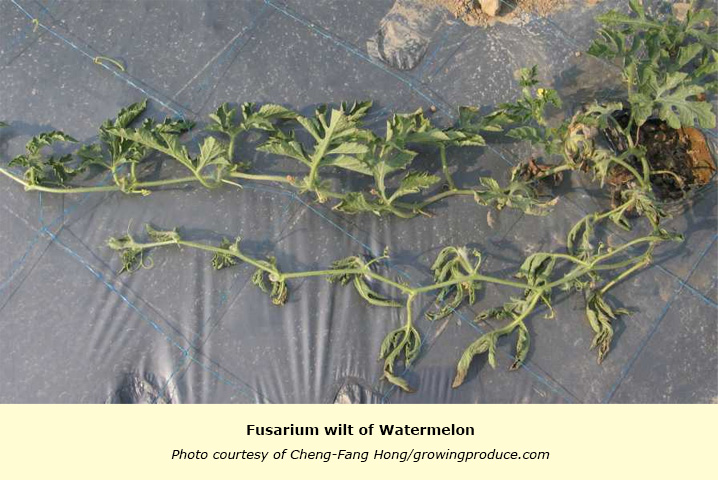Fusarium wilt of watermelon is common problem in Florida where resistant varieties are not used, but it might occur to some extent even when resistant varieties are used. Fusarium wilt is cased by the fungus Fusarium oxysporum fsp. Niveum.

Identification
Typically, the first noticeable symptom is that one side of a plant wilts. This one-sided wilt commonly occurs three to four weeks after transplanting. In older plants, there is marginal, progressing to a general yellowing of the older leaves and wilting of one or more runners. In some cases, sudden collapse occurs without any yellowing of the foliage.
On stems near the crown of the plant, a linear necrotic lesion may develop, extending up the plant and usually on one side of the vine. Infected plants have white, healthy roots, but the vascular tissue is brown and discolored. Slicing the tap root lengthwise into two equal halves will reveal two streaks of vascular tissue that are dark yellow-brown, orange brown or reddish brown. In Florida, Fusarium wilt is likely to occur prior to fruit set.
In the field, infected plants often appear in clusters.
Survival and Spread
The fungus that causes Fusarium wilt in watermelon is very specific and cannot infect even closely related plants such as cucumber and muskmelon. Fusarium forms resilient spores (chlamydospores) that can remain viable in the soil for many years. This means Fusarium wilt may appear in a field that may not have had a suitable host for several seasons.
It also means the disease will not spread from plant to plant, only from spores in the soil. Therefore, any process that moves soil may be responsible for spreading this disease between or within fields. The optimum temperature for infection is near 80°F, with little infection occurring above 86°F.
Fusarium has been found to be associated with seed, but the main importance here would be the potential of introducing a new race into the field from other areas of the world.
Management Methods
Fusarium wilt is difficult to manage. The best control for Fusarium wilt of watermelons is the use of resistant varieties coupled with crop rotation. Long rotations (five years or more) may lessen the survival rate of the fungus spores in the soil and decrease the severity of symptoms. Crop rotation is generally not totally effective because chlamydospores survive so long in the soil and the pathogen can survive in or on the roots of symptomless host plants.
Although no commercial watermelon varieties are completely resistant to Fusarium wilt, some varieties offer partial resistance, which can lessen the impact of this disease.
Fumigation can reduce the incidence and severity of Fusarium wilt but recolonization of the soil occurs very quickly.
Few fungicides are available for fusarium wilt control, but a soil application at transplant with prothioconazole (Proline 480SC, Bayer CropScience) may reduce disease in the field.
Liming the soil to pH 6.0-7.0, as well as reducing nitrogen levels in the soil, may help reduce the incidence of Fusarium wilt.
Written by Gene McAvoy, Growing Produce
